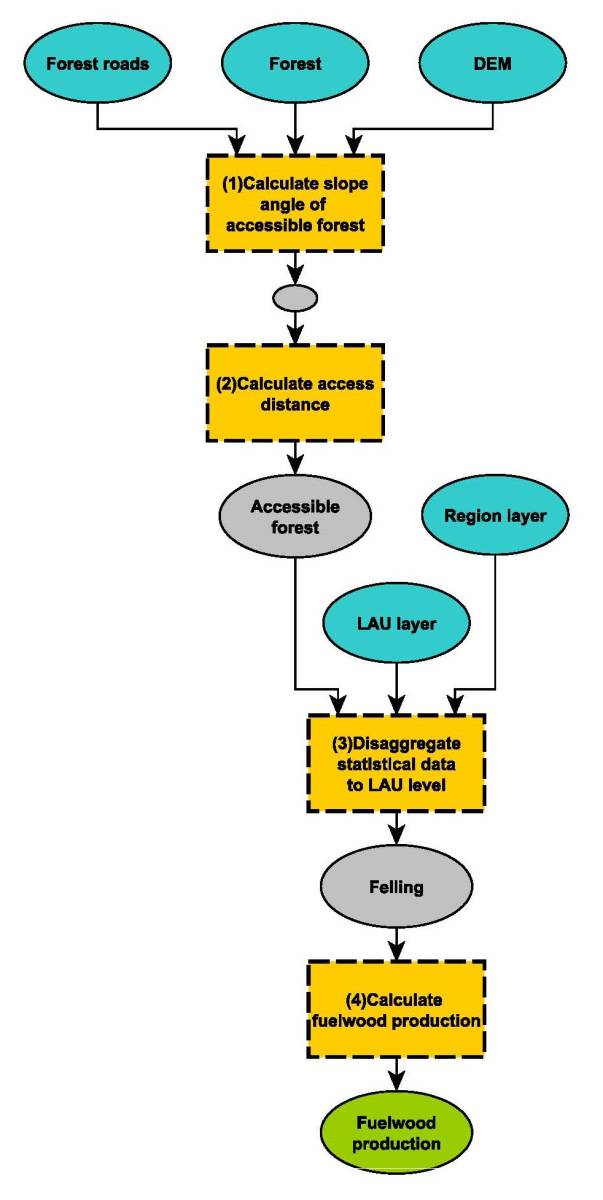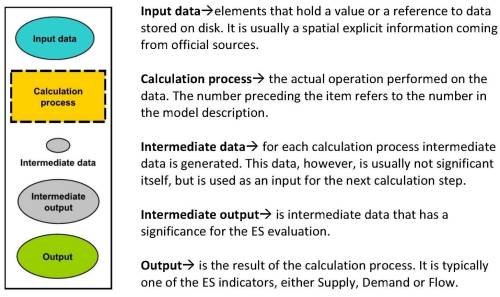Table of Contents
Fuel wood - Flow
General description
<font 14px/inherit;;inherit;;inherit>Not all forests can be managed equally: accessibility (infrastructure) and technical feasibility (due to topography) play a crucial role in sustainable forest management. Hence, this indicator reflects the timber removals for fuel wood production considering both the forest accessibility (based on the OSM layer) and topographical site condition (slope angle from DEM). Data for timber removals are taken from national forestry inventories. Flowchart below describes in detail the calculation procedure to derive the amount of fuelwood (m³/ha/year) produced per local administrative units (LAU2) of the Alpine Space.</font>
<font 14px/inherit;;inherit;;inherit>The procedure consists of two main parts:</font>
- <font 14px/inherit;;inherit;;inherit>Calculation of the accessible forest areas (Step 1 and 2): typically, commercial wood production occurs only on forests that are accessible and workable in terms of topographic conditions. Hence, in the following analysis only accessible and workable forest areas are included.</font>
- <font 14px/inherit;;inherit;;inherit>Calculation of the amount of fuelwood produced in each LAU2 (Step 3 and 4): The statistical data about the amount of felling is disaggregated at LAU2 level using results from part 1.</font>
Input data
<font 14px/inherit;;inherit;;inherit>GIS-Data</font>
- <font 14px/inherit;;inherit;;inherit>Forest roads: open street map layer (OSM)</font>
Source: http://download.geofabrik.de/. The roads classified as “bridleway”, “service”, “track”, “track_grade1”, “track_grade2”, “track_grade3”, “track_grade4”, “track_grade5”, “unclassified” and “unknown” are used.
- Forest: High-resolution tree-cover-density layer
Source: http://land.copernicus.eu/. Pixels with a density between 30-100% are used; forest in agricultural and urban areas is removed.
- Digital Elevation Model: Elevation raster dataset
Source:http://land.copernicus.eu,v1.0
- LAU2 layer: Boundaries of the local administrative units
Source: http://www.eurogeographics.org/products-and-services/euroboundarymap; version 10.
- Region layer:<font 14px/14px;;inherit;;inherit>Boundaries of the areas for which the statistical data is available.Statistical data about the amount of felled wood is typically not available at LAU level; hence, for every country we used the finest available resource. Because these datasets have different resolutions and names, we call them “region layers” in the following description. The original names/resolutions for the different countries are the following:</font>
-Germany: Growing regions
Source: https://gdi.thuenen.de/wo/wgwb/
<font 14px/inherit;;inherit;;inherit>-Switzerland: Production regions</font>*
-France: Nuts 2
Source: http://www.eurogeographics.org/products-and-services/euroboundarymap
-Italy: Nuts 2
Source:http://www.eurogeographics.org/products-and-services/euroboundarymap
-Liechtenstein: Nuts 2
Source: http://www.eurogeographics.org/products-and-services/euroboundarymap
-Austria: “Bezirke”
Source: http://data.opendataportal.at/dataset/geojson-daten-osterreich
<font 14px/inherit;;inherit;;inherit>-Slovenia: Forest regions (dataset provided by the Slovenian Forest Institute)</font>
<font 14px/inherit;;inherit;;inherit>Statistical data</font><font 14px/inherit;;inherit;;inherit>:</font>
- Statistical data about roundwood production: The amount of wood that is extracted from the forest.
Source: Forest inventories of single countries
- Percentage of roundwood transformed into fuelwood
Source: http://ec.europa.eu/eurostat/statistics-explained/index.php/Wood_products_-_production_and_trade
Variables:
- Maximum access distance = 200m (after Clouet, N. and Berger, F., 2009)
Calculation processes
(1) Calculation of the slope angle of accessible forest:Forested areas within the maximum access distance from forest roads are extracted from the original forest layer and their slope is calculated (in %) The 200m serve as a threshold, all pixels that are further away from the street are not considered in the following calculation.
(2) Calculation of access distance: Based on Clouet & Berger (2009), the maximum distance from which every pixel (extracted in Step 1) can be accessed, due to its topographic conditions, is calculated. The access distance of a pixel can be lower than the actual distance from the street and therefore, all pixels that are further away from the road than their access distance are removed.
(3) Disaggregation of statistical data to LAU2 level:The data about the production of roundwood is disaggregated to LAU2 level via the share of accessible forest in every LAU2.
statistical data about fellings/accessible forest in region = average fellings per unit of accessible forest
average felling*accessible forest in LAU= LAU fellings
<font 14px/inherit;;inherit;;inherit>Dividing the statistical data by the accessible forest area in each region gives an average value of the produced roundwood per accessible forest for each region. For all LAUs in the region, this average value is multiplied with the total accessible forest area of the LAU2. The result is the amount of roundwood that is produced in the LAU2.</font>
(4) Calculation of fuelwood production: With statistical data about the share of roundwood that is transformed into fuelwood, the amount of fuelwood that is produced in every LAU2 is estimated.


<font 12px/inherit;;inherit;;inherit>References:</font>
<font 12px/inherit;;inherit;;inherit>Clouet, N.; Berger, F. (2009): Modélisation des surfaces débardables au tracteur forestier en zone de montagne. SIG 2009. Confeérence Francophone ESRI</font>